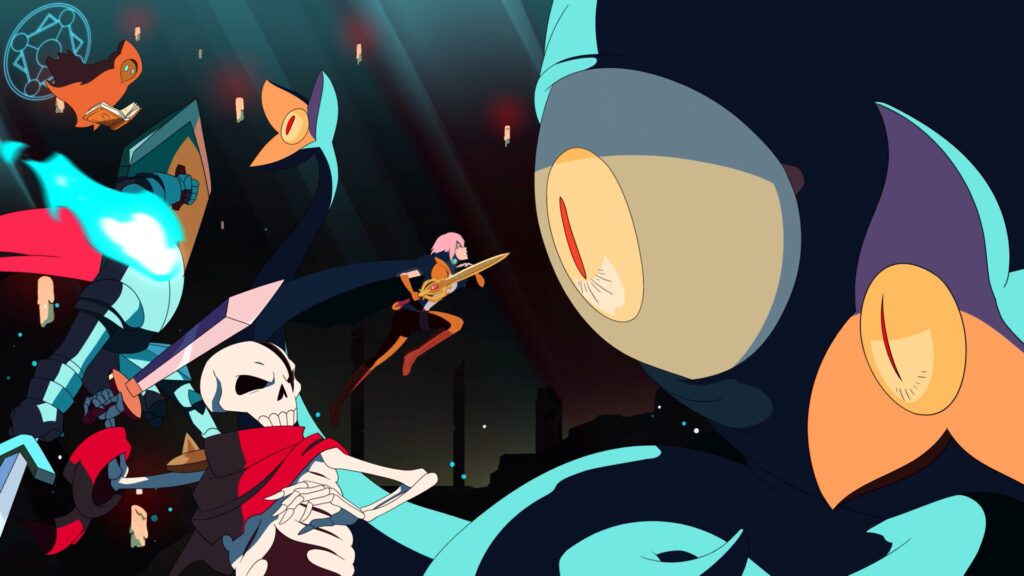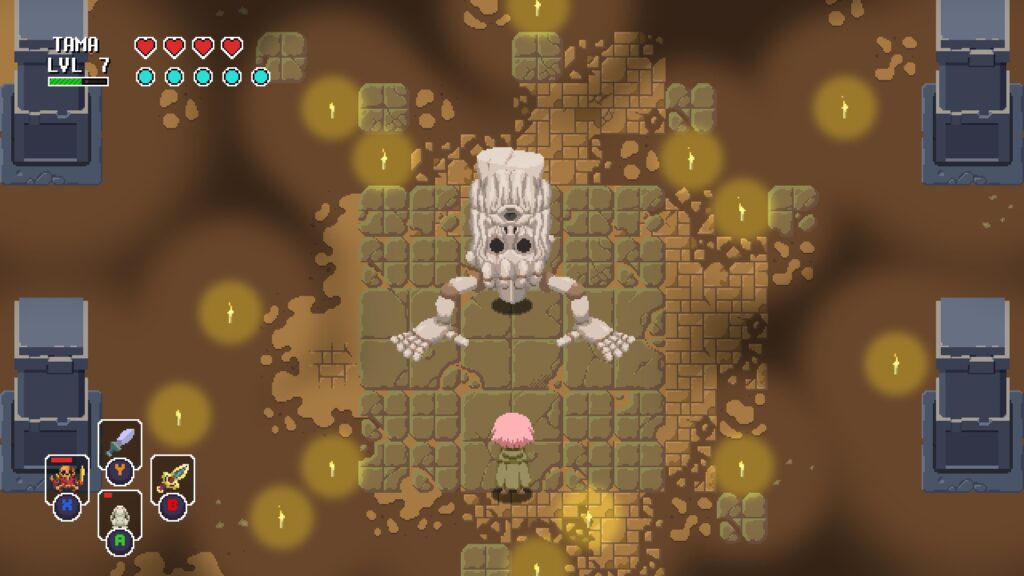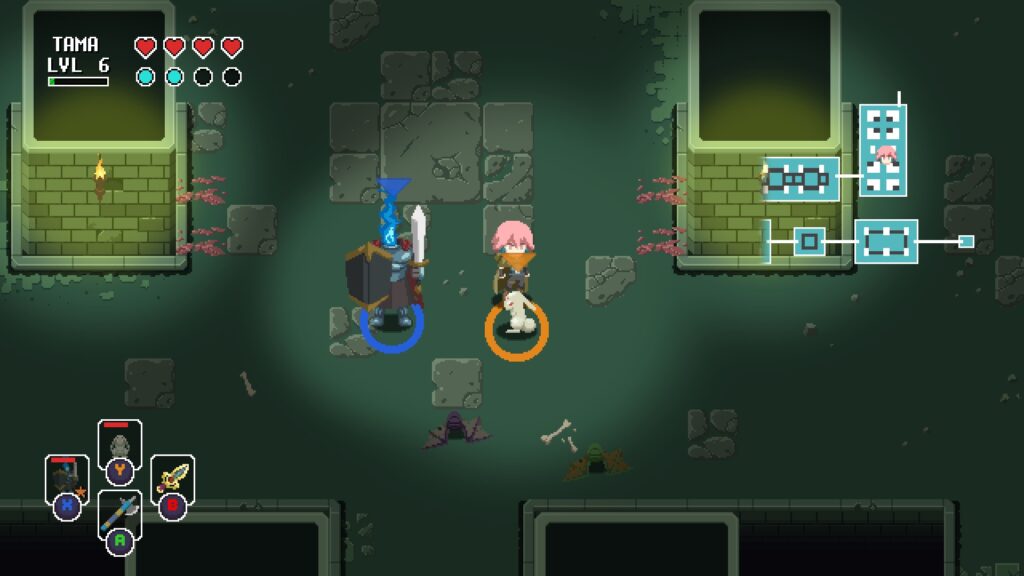
Sword of the Necromancer Is the Sapphic Princess/Bodyguard Game I’ve Always Wanted
Sword of the Necromancer popped up on my radar rather late, and I deeply regret it because it’s easily the most exciting game I’ve played this year. It’s a game that takes on story tropes and beats that’ll hook in anyone who is even vaguely interested in a sapphic version of a princess/bodyguard love story.
A love story that, unfortunately, goes wrong. You play as Tama, a mercenary and the bodyguard of the High Priestess of Nodam, Koko. Something happened during your trip together that’s led to the demise of your love. Losing Koko however, is something that Tama is unable to accept and so we start our journey in the Crypt of the Necromancer – looking for the sword that’ll bring Koko back to life.
But as we all know, it’s going to take more than the Sword of the Necromancer to bring back a human soul. That’s where the dungeon crawling, action, adventure comes in and, with a glance back to Koko, we head off into the depths of the dungeon.
Each dungeon in this game, as well as the weapons you find scattered around, is procedurally generated so that no matter how many times you play, there’s always going to be something different than the last time. A different variant of enemy perhaps, or fewer treasure chests and loot. It makes preparing for each level of dungeon feel dangerous, as you never know whether you’re going to go up against measly Flayers – bat-like creatures that take 2 hits to kill – or bloody annoying Impeachers that’ll release three arrows right into your backside when you aren’t looking.
Of course, after playing around about 15 hours of the game, you do get a sense of what goes where and which weapons do better against what sort of enemy, the enemies movements, and how to avoid them, but it feels just like slipping on your slippers after getting up in the morning – quite natural. That doesn’t exactly negate the difficulty of the game, but it puts into perspective how, as with most things, practice makes perfect.

Unfortunately, the dangers of the dungeons get lost in the boss fights which, after realizing the unique pattern that they all have, becomes painfully easy to exploit. One boss enemy will always have a move where they spray off a ton of dark orbs or shockwaves after you hit them a certain amount of times, or a boss character’s skeletal hands are easy to avoid if you just hide behind a pillar. It feels too easy and I was disappointed that, after a certain important moment in the game, that these boss fights didn’t change anything up.
Despite the lack of difficulty in boss fights, Sword of the Necromancer is far from stale – and I’m not just talking about the combat. After dying a number of times – which means I lost half a level from what I’d gained during my time in the dungeons, as well as my allies and weapons – I was given the Game Settings option. It let me up the difficulty, which indeed made boss fights harder and more engaging, but it offered more than that too by allowing me to pick whether I wanted my level to decrease and lose my items and allies when I died. While not necessarily on the same level as Hades helpful God Mode, I appreciated how the game allowed players to choose the right difficulty level for them.
As fun as the dungeon crawling is strategic, the twists and turns of the story between Tama and Koko is what really encouraged me to continue playing the game until the very early hours of the morning. I wanted to find out more about them, what their goals were, and how they came to be together as both the High Priestess and her bodyguard, as well as their eventual relationship. That and straight people always get the princess/bodyguard romance and as fun as it is to read about it in fiction, there’s something quite different about being an interactive part of a queer romance story.
And what a romance it is! From the very beginning these two women have no choice but to depend on one another, but for two different reasons. For Koko, her allegiance with Tama means she can carry out a pilgrimage and see the world with her own eyes – and without her father interfering – rather than read about it in a book. For Tama it allows her to be free from under the thumb of her bandit group who, despite having looked after her since she was a child, treat her as a tool rather than a person. Both of them have their reasons to be with one another, even if at first their relationship is purely business.

As you progress through the dungeons, Sword of the Necromancer rewards your hard work by offering you a slice of the growing relationship between Tama and Koko. These slices of conversations and interaction aren’t as in-depth as Hades, but you shouldn’t expect them to be. This is Tama and Koko’s story, and while there are a few characters you meet in the memories you’re given – none of them have quite the same emotional weight as our heroines. Instead of focusing on an overarching plot with buckets of lore, these memories instead convey how Tama and Koko came to love one another.
This may seem all well and good, but Sword of the Necromancer doesn’t hide that Koko is dead at the very start of the game. Anyone who knows me knows my particular aversion to the dead lesbian trope but, without spoiling anything about the story, this game doesn’t quite fall into that same hole and, in fact, makes the act of dying feel like just another thing for Tama to conquer to save the person she loves.
Tama chooses to defy, to rebel against the laws of nature to save Koko and that rebellion is key to making this game undeniably queer. As eye-rolling as it was for Tama to question her attraction to Koko because of them being women and that it goes against the religious teachings that Koko is part of, it conveyed something that we, as queer individuals, have always known: we go against the status quo. Our existence is treasonous in a cis-hetero, patriarchal society, and we’re expected to stick to the role we’ve been born or forced into.
For Tama and Koko, they begin to reject the roles given to them the moment they realize that, regardless of what happens in the world, they don’t want to handle it without the other by their side. Instead of planning to return home after the pilgrimage is done, Koko decides she’ll continue traveling and helping people with direct action. She believes she can do it, as long as Tama is by her side. It’s a relationship that is emblazoned by the fires of revolution, and it’s those flames that get stoked when Koko dies and Tama turns her back on what is ‘right’ by nature to do anything to get Koko back. It’s a story that I didn’t expect to see in a dungeon crawler where you can reanimate dead things to do your bidding but god, am I so glad it exists.

Overall, Sword of the Necromancer is a rewarding roguelike that not only puts women in front and center of the game, but their love for one another is what fuels the game’s very existence. It’s the perfect blend of dungeon crawler and visual novel, and I sincerely hope that Grimorio of Games continues to create such rich, and fulfilling games like this one.
To put it bluntly, it’s the sapphic Princess/Bodyguard that I’ve always wanted in video games. And if you’re looking for that same thing, then don’t look any further than Sword of the Necromancer.
The Verdict: 4.5/5
Sword of the Necromancer is available from 28th January on PC (version tested), PS4, PS5, Xbox One, Xbox X/S and Switch







